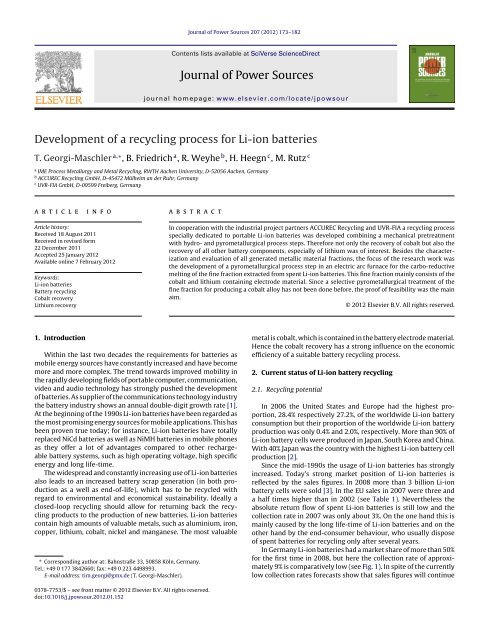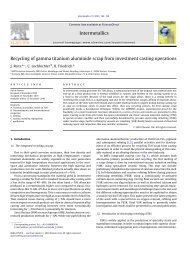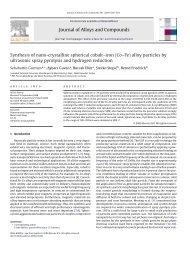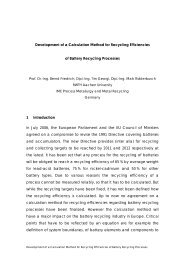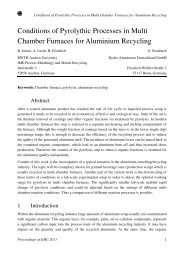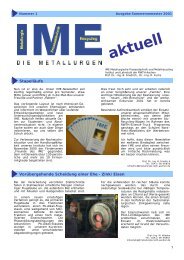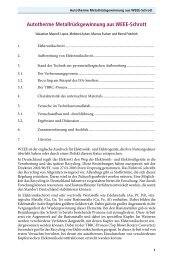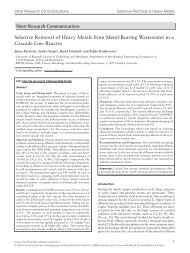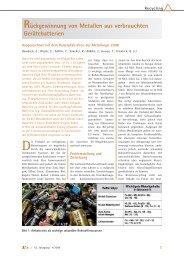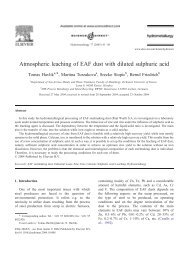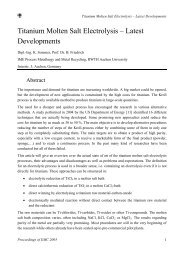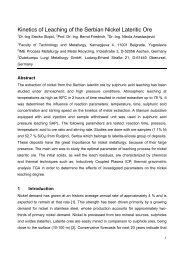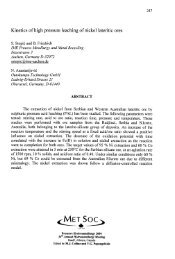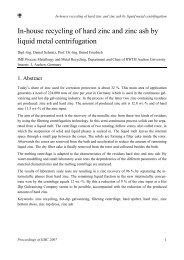Development of a recycling process for Li-ion batteries
Development of a recycling process for Li-ion batteries
Development of a recycling process for Li-ion batteries
- No tags were found...
Create successful ePaper yourself
Turn your PDF publications into a flip-book with our unique Google optimized e-Paper software.
Journal <strong>of</strong> Power Sources 207 (2012) 173–182<br />
Contents lists available at SciVerse ScienceDirect<br />
Journal <strong>of</strong> Power Sources<br />
jo ur nal homep age: www.elsevier.com/locate/jpowsour<br />
<strong>Development</strong> <strong>of</strong> a <strong>recycling</strong> <strong>process</strong> <strong>for</strong> <strong>Li</strong>-<strong>ion</strong> <strong>batteries</strong><br />
T. Georgi-Maschler a,∗ ,B. Friedrich a ,R. Weyhe b ,H. Heegn c , M. Rutz c<br />
a IME Process Metallurgy and Metal Recycling, RWTH Aachen University, D-52056 Aachen, Germany<br />
b ACCUREC Recycling GmbH, D-45472 Mülheim an der Ruhr, Germany<br />
c UVR-FIA GmbH, D-09599 Freiberg, Germany<br />
a r t i c l e i n f o<br />
Article history:<br />
Received 18 August 2011<br />
Received in revised <strong>for</strong>m<br />
22 December 2011<br />
Accepted 25 January 2012<br />
Available online 7 February 2012<br />
Keywords:<br />
<strong>Li</strong>-<strong>ion</strong> <strong>batteries</strong><br />
Battery <strong>recycling</strong><br />
Cobalt recovery<br />
<strong>Li</strong>thium recovery<br />
a b s t r a c t<br />
In cooperat<strong>ion</strong> with the industrial project partners ACCUREC Recycling and UVR-FIA a <strong>recycling</strong> <strong>process</strong><br />
specially dedicated to portable <strong>Li</strong>-<strong>ion</strong> <strong>batteries</strong> was developed combining a mechanical pretreatment<br />
with hydro- and pyrometallurgical <strong>process</strong> steps. There<strong>for</strong>e not only the recovery <strong>of</strong> cobalt but also the<br />
recovery <strong>of</strong> all other battery components, especially <strong>of</strong> lithium was <strong>of</strong> interest. Besides the characterizat<strong>ion</strong><br />
and evaluat<strong>ion</strong> <strong>of</strong> all generated metallic material fract<strong>ion</strong>s, the focus <strong>of</strong> the research work was<br />
the development <strong>of</strong> a pyrometallurgical <strong>process</strong> step in an electric arc furnace <strong>for</strong> the carbo-reductive<br />
melting <strong>of</strong> the fine fract<strong>ion</strong> extracted from spent <strong>Li</strong>-<strong>ion</strong> <strong>batteries</strong>. This fine fract<strong>ion</strong> mainly consists <strong>of</strong> the<br />
cobalt and lithium containing electrode material. Since a selective pyrometallurgical treatment <strong>of</strong> the<br />
fine fract<strong>ion</strong> <strong>for</strong> producing a cobalt alloy has not been done be<strong>for</strong>e, the pro<strong>of</strong> <strong>of</strong> feasibility was the main<br />
aim.<br />
© 2012 Elsevier B.V. All rights reserved.<br />
1. Introduct<strong>ion</strong><br />
Within the last two decades the requirements <strong>for</strong> <strong>batteries</strong> as<br />
mobile energy sources have constantly increased and have become<br />
more and more complex. The trend towards improved mobility in<br />
the rapidly developing fields <strong>of</strong> portable computer, communicat<strong>ion</strong>,<br />
video and audio technology has strongly pushed the development<br />
<strong>of</strong> <strong>batteries</strong>. As supplier <strong>of</strong> the communicat<strong>ion</strong>s technology industry<br />
the battery industry shows an annual double-digit growth rate [1].<br />
At the beginning <strong>of</strong> the 1990s <strong>Li</strong>-<strong>ion</strong> <strong>batteries</strong> have been regarded as<br />
the most promising energy sources <strong>for</strong> mobile applicat<strong>ion</strong>s. This has<br />
been proven true today; <strong>for</strong> instance, <strong>Li</strong>-<strong>ion</strong> <strong>batteries</strong> have totally<br />
replaced NiCd <strong>batteries</strong> as well as NiMH <strong>batteries</strong> in mobile phones<br />
as they <strong>of</strong>fer a lot <strong>of</strong> advantages compared to other rechargeable<br />
battery systems, such as high operating voltage, high specific<br />
energy and long life-time.<br />
The widespread and constantly increasing use <strong>of</strong> <strong>Li</strong>-<strong>ion</strong> <strong>batteries</strong><br />
also leads to an increased battery scrap generat<strong>ion</strong> (in both product<strong>ion</strong><br />
as a well as end-<strong>of</strong>-life), which has to be recycled with<br />
regard to environmental and economical sustainability. Ideally a<br />
closed-loop <strong>recycling</strong> should allow <strong>for</strong> returning back the <strong>recycling</strong><br />
products to the product<strong>ion</strong> <strong>of</strong> new <strong>batteries</strong>. <strong>Li</strong>-<strong>ion</strong> <strong>batteries</strong><br />
contain high amounts <strong>of</strong> valuable metals, such as aluminium, iron,<br />
copper, lithium, cobalt, nickel and manganese. The most valuable<br />
∗ Corresponding author at: Bahnstraße 33, 50858 Köln, Germany.<br />
Tel.: +49 0 177 3842660; fax: +49 0 223 4498993.<br />
E-mail address: tim.georgi@gmx.de (T. Georgi-Maschler).<br />
metal is cobalt, which is contained in the battery electrode material.<br />
Hence the cobalt recovery has a strong influence on the economic<br />
efficiency <strong>of</strong> a suitable battery <strong>recycling</strong> <strong>process</strong>.<br />
2. Current status <strong>of</strong> <strong>Li</strong>-<strong>ion</strong> battery <strong>recycling</strong><br />
2.1. Recycling potential<br />
In 2006 the United States and Europe had the highest proport<strong>ion</strong>,<br />
28.4% respectively 27.2%, <strong>of</strong> the worldwide <strong>Li</strong>-<strong>ion</strong> battery<br />
consumpt<strong>ion</strong> but their proport<strong>ion</strong> <strong>of</strong> the worldwide <strong>Li</strong>-<strong>ion</strong> battery<br />
product<strong>ion</strong> was only 0.4% and 2.0%, respectively. More than 90% <strong>of</strong><br />
<strong>Li</strong>-<strong>ion</strong> battery cells were produced in Japan, South Korea and China.<br />
With 40% Japan was the country with the highest <strong>Li</strong>-<strong>ion</strong> battery cell<br />
product<strong>ion</strong> [2].<br />
Since the mid-1990s the usage <strong>of</strong> <strong>Li</strong>-<strong>ion</strong> <strong>batteries</strong> has strongly<br />
increased. Today’s strong market posit<strong>ion</strong> <strong>of</strong> <strong>Li</strong>-<strong>ion</strong> <strong>batteries</strong> is<br />
reflected by the sales figures. In 2008 more than 3 bill<strong>ion</strong> <strong>Li</strong>-<strong>ion</strong><br />
battery cells were sold [3]. In the EU sales in 2007 were three and<br />
a half times higher than in 2002 (see Table 1). Nevertheless the<br />
absolute return flow <strong>of</strong> spent <strong>Li</strong>-<strong>ion</strong> <strong>batteries</strong> is still low and the<br />
collect<strong>ion</strong> rate in 2007 was only about 3%. On the one hand this is<br />
mainly caused by the long life-time <strong>of</strong> <strong>Li</strong>-<strong>ion</strong> <strong>batteries</strong> and on the<br />
other hand by the end-consumer behaviour, who usually dispose<br />
<strong>of</strong> spent <strong>batteries</strong> <strong>for</strong> <strong>recycling</strong> only after several years.<br />
In Germany <strong>Li</strong>-<strong>ion</strong> <strong>batteries</strong> had a market share <strong>of</strong> more than 50%<br />
<strong>for</strong> the first time in 2008, but here the collect<strong>ion</strong> rate <strong>of</strong> approximately<br />
9% is comparatively low (see Fig. 1). In spite <strong>of</strong> the currently<br />
low collect<strong>ion</strong> rates <strong>for</strong>ecasts show that sales figures will continue<br />
0378-7753/$ – see front matter © 2012 Elsevier B.V. All rights reserved.<br />
doi:10.1016/j.jpowsour.2012.01.152
174 T. Georgi-Maschler et al. / Journal <strong>of</strong> Power Sources 207 (2012) 173–182<br />
Table 1<br />
EU sales figures, return flows and collect<strong>ion</strong> rates <strong>of</strong> <strong>Li</strong>-<strong>ion</strong> <strong>batteries</strong> (2002–2007)<br />
(source: ACCUREC Recycling).<br />
2002 2003 2004 2005 2006 2007<br />
Sales in tonnes 3771 4977 6712 8210 9138 13,181<br />
Return in tonnes 17 54 170 175 418 354<br />
Collect<strong>ion</strong> in % 0.5 1.1 2.5 2.1 4.6 2.7<br />
to increase up to more than 30,000 tonnes in 2015 and the market<br />
share <strong>of</strong> <strong>Li</strong>-<strong>ion</strong> <strong>batteries</strong> will be far above 50%. As a consequence also<br />
a strong increase <strong>of</strong> the return flow can be expected. That means<br />
that suitable <strong>recycling</strong> <strong>process</strong>es have to be established, which have<br />
the capacities to <strong>process</strong> the upcoming <strong>recycling</strong> flow.<br />
In 2006, the European Parliament and the EU Council <strong>of</strong> Ministers<br />
agreed on a compromise to revise the 1991 Battery Directive<br />
91/157/EEC covering <strong>batteries</strong> and accumulators. Since 2008 the<br />
new Battery Directive 2006/66/EC prescribes the currently valid<br />
collecting targets and <strong>recycling</strong> efficiencies. It has been set that<br />
member states are obliged to reach a minimum collect<strong>ion</strong> rate<br />
<strong>for</strong> spent <strong>batteries</strong> and accumulators <strong>of</strong> 25% by 2012 and <strong>of</strong> 45%<br />
by 2016. Furthermore <strong>Li</strong>-<strong>ion</strong> battery <strong>recycling</strong> <strong>process</strong>es will be<br />
obliged to reach a minimum <strong>recycling</strong> efficiency <strong>of</strong> 50% by average<br />
weight [4–6].<br />
According to the EU Battery Directive the <strong>recycling</strong> <strong>of</strong> <strong>batteries</strong><br />
means the “<strong>process</strong>ing <strong>of</strong> waste <strong>batteries</strong> and accumulators <strong>for</strong><br />
generat<strong>ion</strong> <strong>of</strong> products that can be directly reused in battery product<strong>ion</strong><br />
or in other applicat<strong>ion</strong>s or <strong>process</strong>es” [6]. The definit<strong>ion</strong><br />
excludes the possibilities <strong>of</strong> disposal or energy recovery. Un<strong>for</strong>tunately<br />
a repair and reuse <strong>of</strong> spent <strong>batteries</strong> is impossible. Thus the<br />
only way <strong>of</strong> <strong>recycling</strong> is the recovery <strong>of</strong> value materials (not only<br />
metals).<br />
At least one-third <strong>of</strong> the product<strong>ion</strong> costs <strong>for</strong> a portable <strong>Li</strong>-<strong>ion</strong><br />
battery cell are related to the materials [2,8]. This is due to the fact<br />
that <strong>Li</strong>-<strong>ion</strong> battery cells contain high amounts <strong>of</strong> valuable metals<br />
which are present in metallic <strong>for</strong>m as well as in the <strong>for</strong>m <strong>of</strong> inorganic<br />
metallic compounds. Examples <strong>of</strong> metallic battery components are<br />
the casing, the electrode foils as well as electronic components.<br />
Examples <strong>of</strong> inorganic metallic components are the active cathode<br />
material and the conducting salts contained in the electrolyte.<br />
Today’s <strong>recycling</strong> <strong>process</strong>es mainly aim at metal recovery but also<br />
organic battery components, such as the electrolyte and plastics,<br />
should be taken into considerat<strong>ion</strong> since the addit<strong>ion</strong>al recovery<br />
<strong>of</strong> such components at least help to increase the total <strong>recycling</strong><br />
efficiency.<br />
Fig. 1. Sales figures, return flows and collect<strong>ion</strong> rates <strong>of</strong> <strong>Li</strong>-<strong>ion</strong> <strong>batteries</strong> in Germany<br />
(2000–2009) [7].<br />
Table 2<br />
Average material content <strong>of</strong> portable <strong>Li</strong>-<strong>ion</strong> <strong>batteries</strong>.<br />
Battery component Product data sheets Self-determined<br />
in mass-%<br />
Casing ∼20–25 ∼25<br />
Cathode material (<strong>Li</strong>CoO 2) ∼25–30 ∼25<br />
Anode material (graphite) ∼14–19 ∼17<br />
Electrolyte ∼10–15 ∼10<br />
Copper electrode foil ∼5–9 ∼8<br />
Aluminium electrode foil ∼5–7 ∼5<br />
Separator – ∼4<br />
Others Balance Balance<br />
Since all battery producers sell their own specific types <strong>of</strong> <strong>Li</strong><strong>ion</strong><br />
<strong>batteries</strong> it is difficult to specify exact numbers <strong>for</strong> the material<br />
content <strong>of</strong> a <strong>Li</strong>-<strong>ion</strong> battery scrap mixture. In order to give some<br />
numbers a study <strong>of</strong> various product data sheets from different battery<br />
producers has been done. Also, <strong>Li</strong>-<strong>ion</strong> <strong>batteries</strong> from a typical<br />
product<strong>ion</strong> scrap charge have been disassembled by hand and the<br />
battery components were separated and weighed. The results are<br />
listed in Table 2.<br />
Based on the assumpt<strong>ion</strong>s that the metal content (selfdetermined<br />
figures) can completely be recovered in metallic <strong>for</strong>m<br />
and that the lithium content can completely be recovered in the<br />
<strong>for</strong>m <strong>of</strong> lithium carbonate the monetary value <strong>of</strong> 1 tonne <strong>Li</strong>-<strong>ion</strong><br />
battery scrap is approximately US$ 8500 taking current raw material<br />
prices into account. The monetary value <strong>of</strong> the cobalt content<br />
is already about US$ 7200.<br />
2.2. Industrial <strong>recycling</strong> <strong>process</strong>es<br />
Various battery <strong>recycling</strong> <strong>process</strong>es exist which can basically be<br />
divided into pyrometallurgical and hydrometallurgical <strong>process</strong>es.<br />
Some <strong>recycling</strong> <strong>process</strong>es combine pyro- and hydrometallurgical<br />
steps and <strong>of</strong>ten have integrated pre-treatment steps like pyrolysis<br />
or mechanical <strong>process</strong>ing, i.e. crushing and material separat<strong>ion</strong>.<br />
Besides utilisat<strong>ion</strong> <strong>of</strong> specialised battery <strong>recycling</strong> <strong>process</strong>es the<br />
addit<strong>ion</strong> <strong>of</strong> spent <strong>batteries</strong> to existing large-scale <strong>process</strong>es, which<br />
are not dedicated to battery <strong>recycling</strong> (e.g. extractive cobalt or<br />
nickel metallurgy) is common practice and very <strong>of</strong>ten an economical<br />
advantage. Process examples <strong>for</strong> each category are given as<br />
follows.<br />
The company Batrec mainly runs a mechanical <strong>process</strong>ing plant<br />
<strong>for</strong> <strong>Li</strong>-<strong>ion</strong> battery cells. The <strong>batteries</strong> are crushed in CO 2 gas atmosphere.<br />
Thereby the volatile organic electrolyte evaporates and is<br />
collected as non-usable condensate. A subsequent material separat<strong>ion</strong><br />
is done and the different material fract<strong>ion</strong>s are sold and<br />
represent feedstock materials in other <strong>process</strong>es [10–17].<br />
Originally the hydrometallurgical Toxco <strong>process</strong> was developed<br />
<strong>for</strong> the safe <strong>recycling</strong> <strong>of</strong> spent lithium primary <strong>batteries</strong>. Today’s<br />
facility <strong>process</strong>es lithium secondary battery scrap as well. The scrap<br />
is stored in earth covered concrete storage bunkers. Residual electrical<br />
energy is removed from larger and more reactive <strong>batteries</strong>. If<br />
necessary the <strong>batteries</strong> are treated by Toxco’s patented cryogenic<br />
<strong>process</strong>, i.e. they are cooled to about −200 ◦ C. <strong>Li</strong>thium, although<br />
normally explosively reactive at room temperature, behaves almost<br />
inert at this temperature. The <strong>batteries</strong> are then safely shredded and<br />
the materials are separated. Metals from the <strong>batteries</strong> are collected<br />
and sold. The lithium components are separated and converted to<br />
lithium carbonate <strong>for</strong> resale. If the <strong>batteries</strong> contain cobalt it is<br />
also recovered <strong>for</strong> product<strong>ion</strong> <strong>of</strong> <strong>Li</strong>CoO 2 as new battery electrode<br />
material [9,11,12,18–20].<br />
The pyrometallurgical Inmetco <strong>process</strong> was developed <strong>for</strong><br />
the <strong>recycling</strong> <strong>of</strong> spent NiCd, NiMH as well as <strong>Li</strong>-<strong>ion</strong> <strong>batteries</strong>.<br />
Thereby only a small amount <strong>of</strong> <strong>Li</strong>-<strong>ion</strong> battery scrap is charged<br />
into an electric arc furnace as secondary feedstock besides iron
T. Georgi-Maschler et al. / Journal <strong>of</strong> Power Sources 207 (2012) 173–182 175<br />
containing material. The main aim is the recovery <strong>of</strong> cobalt, nickel<br />
and iron <strong>for</strong> the product<strong>ion</strong> <strong>of</strong> an iron-based alloy. Ignoble metals<br />
are slagged and organic materials as well as carbon are burned and<br />
used as reducing agents [11,12,21,22]. The Inmetco <strong>process</strong> is not<br />
a dedicated <strong>Li</strong>-<strong>ion</strong> battery <strong>recycling</strong> <strong>process</strong>, i.e. most <strong>of</strong> the battery<br />
components including the lithium contents are lost during the<br />
<strong>process</strong>.<br />
Since 2001 cobalt and nickel containing battery scrap is added<br />
as secondary feedstock material in the extractive cobalt, nickel<br />
and copper <strong>process</strong> routes at Xstrata. Thus only the cobalt, nickel<br />
and copper contents <strong>of</strong> spent <strong>Li</strong>-<strong>ion</strong> <strong>batteries</strong> are <strong>of</strong> interest. All<br />
other battery materials are slagged or used as energy source and<br />
as reducing agents. The <strong>process</strong> includes pyrometallurgical as well<br />
as hydrometallurgical <strong>process</strong> steps [23–26]. Similar to the Inmetco<br />
<strong>process</strong>, the Xstrata <strong>process</strong> is also not dedicated to <strong>Li</strong>-<strong>ion</strong> <strong>batteries</strong>.<br />
The Umicore VAL’EAS TM <strong>process</strong> represents a dedicated combined<br />
pyro- and hydrometallurgical battery <strong>recycling</strong> <strong>process</strong> <strong>for</strong><br />
spent <strong>Li</strong>-<strong>ion</strong> and NiMH <strong>batteries</strong>. The battery scrap is directly<br />
melted down in a purpose-built shaft furnace without any kind<br />
<strong>of</strong> pre-treatment. Umicore is also a producer <strong>of</strong> cathode material<br />
<strong>for</strong> <strong>Li</strong>-<strong>ion</strong> <strong>batteries</strong>, i.e. the <strong>recycling</strong> <strong>process</strong> aims at a closed-loop<br />
recovery <strong>of</strong> cobalt and nickel in <strong>for</strong>m <strong>of</strong> <strong>Li</strong>CoO 2 and Ni(OH) 2 . Ignoble<br />
metals, such as aluminium and lithium, are lost whereas copper,<br />
iron and manganese are recovered in an aqueous solut<strong>ion</strong>. Organic<br />
materials as well as carbon are burned and used as reducing agents<br />
[27–31].<br />
A big disadvantage <strong>of</strong> all pyrometallurgical <strong>recycling</strong> <strong>process</strong>es<br />
is the fact that lithium cannot be recovered. Thus a combinat<strong>ion</strong> <strong>of</strong><br />
pyro- and hydrometallurgical <strong>process</strong> steps is necessary as is the<br />
case <strong>for</strong> the Umicore <strong>process</strong>. However the Umicore <strong>process</strong> does<br />
not aim at the recovery <strong>of</strong> lithium which is the main disadvantage.<br />
Furthermore ignoble metals are slagged and organic materials as<br />
well as carbon are lost. There<strong>for</strong>e an alternative competing <strong>recycling</strong><br />
<strong>process</strong> based on pyro- and hydrometallurgical <strong>process</strong> steps<br />
should also consider an appropriate pre-treatment to recover as<br />
many battery components as possible. Especially the increasing use<br />
<strong>of</strong> <strong>Li</strong>-<strong>ion</strong> battery technology in (hybrid) electric vehicles and hence<br />
the strong growing future demand <strong>for</strong> lithium call <strong>for</strong> such <strong>recycling</strong><br />
solut<strong>ion</strong>s.<br />
3. Methods and materials<br />
3.1. Aim, methodology and practical approach<br />
The following research work was done within the joint research<br />
project “Recovery <strong>of</strong> raw materials from <strong>Li</strong>-<strong>ion</strong> <strong>batteries</strong>” with<br />
the reference number 01RW0404 funded by the German Federal<br />
Ministry <strong>of</strong> Educat<strong>ion</strong> and Research. In cooperat<strong>ion</strong> with the industrial<br />
project partners ACCUREC Recycling GmbH (Mülheim a.d.R.)<br />
and UVR-FIA GmbH (Freiberg) a <strong>recycling</strong> <strong>process</strong> dedicated to<br />
portable <strong>Li</strong>-<strong>ion</strong> <strong>batteries</strong> has been developed combining a mechanical<br />
pre-treatment with hydro- and pyrometallurgical <strong>process</strong> steps<br />
to achieve a preferably high <strong>recycling</strong> efficiency. There<strong>for</strong>e it is not<br />
only focused on the recovery <strong>of</strong> cobalt but also on the recovery <strong>of</strong><br />
all other battery components, especially <strong>of</strong> lithium.<br />
Besides the characterizat<strong>ion</strong> and evaluat<strong>ion</strong> <strong>of</strong> all generated<br />
metallic material fract<strong>ion</strong>s, the main focus is the development <strong>of</strong><br />
a pyrometallurgical <strong>process</strong> step in an electric arc furnace <strong>for</strong> the<br />
carbo-reductive melting <strong>of</strong> the fine fract<strong>ion</strong> extracted from spent<br />
<strong>Li</strong>-<strong>ion</strong> <strong>batteries</strong>. This fine fract<strong>ion</strong> mainly contains the cobalt and<br />
lithium containing electrode material. Since a selective pyrometallurgical<br />
treatment <strong>of</strong> the fine fract<strong>ion</strong> <strong>for</strong> producing a cobalt alloy<br />
has not been tested be<strong>for</strong>e, the pro<strong>of</strong> <strong>of</strong> feasibility is the main aim.<br />
The <strong>process</strong>ing in the electric arc furnace requires a <strong>process</strong> slag<br />
to keep cobalt losses at a minimum. With help <strong>of</strong> thermochemical<br />
modelling slag composit<strong>ion</strong>s are chosen with due considerat<strong>ion</strong> <strong>of</strong><br />
the procedural demands and are evaluated in lab-scale trials (5 kgscale).<br />
The suitability <strong>of</strong> the prioritized slag composit<strong>ion</strong> is finally<br />
verified in a 16-h melting campaign in technical-scale (200 kgscale).<br />
The <strong>recycling</strong> products <strong>of</strong> the pyrometallurgical <strong>process</strong> step are<br />
a cobalt alloy as well as lithium containing concentrates. The latter<br />
are further treated hydrometallurgically to produce a pure lithium<br />
carbonate. Other material fract<strong>ion</strong>s generated within the <strong>recycling</strong><br />
<strong>process</strong> are an iron-nickel fract<strong>ion</strong>, an aluminium fract<strong>ion</strong> as well as<br />
a fract<strong>ion</strong> which contains the aluminium and the copper electrode<br />
foils.<br />
By means <strong>of</strong> a critical mass balance the <strong>recycling</strong> efficiency is<br />
calculated, which has to comply with the legal minimum requirements<br />
and, last but not least, with competing industrial <strong>recycling</strong><br />
<strong>process</strong>es. Finally the economic efficiency <strong>of</strong> the <strong>process</strong> shows that<br />
the cost effectiveness is strongly dependent on the cobalt price. The<br />
flow chart <strong>of</strong> the total <strong>recycling</strong> <strong>process</strong> is shown in Fig. 2.<br />
3.2. Process descript<strong>ion</strong> and characterizat<strong>ion</strong> <strong>of</strong> single material<br />
fract<strong>ion</strong>s<br />
Three different charges <strong>of</strong> <strong>Li</strong>-<strong>ion</strong> battery scrap are <strong>process</strong>ed.<br />
Two <strong>of</strong> them are pure product<strong>ion</strong> scrap charges with two different<br />
manganese contents. Those are used in the lab-scale tests. The third<br />
scrap charge represents a mixture <strong>of</strong> spent <strong>Li</strong>-<strong>ion</strong> <strong>batteries</strong> with<br />
no manganese content. This charge is used in the technical-scale<br />
melting campaign. During <strong>process</strong>ing different material fract<strong>ion</strong>s<br />
are generated which are characterized and evaluated.<br />
During pre-treatment the <strong>Li</strong>-<strong>ion</strong> battery packs are disassembled<br />
and the single battery cells are laid open. Thereby a material fract<strong>ion</strong><br />
which contains electronic parts and plastics is generated. Due<br />
to the copper content this material fract<strong>ion</strong> can be regarded as valuable<br />
secondary raw material which can be further <strong>process</strong>ed in an<br />
ISA/Ausmelt bath melting <strong>process</strong>. Reselling to companies that are<br />
specialized in copper <strong>recycling</strong> should there<strong>for</strong>e be the best solut<strong>ion</strong><br />
<strong>for</strong> further <strong>process</strong>ing.<br />
The second <strong>process</strong> step contains a pyrolysis in a resistance<br />
heated retort furnace at temperatures <strong>of</strong> maximum 250 ◦ C. The<br />
battery cells are deactivated safely <strong>for</strong> further <strong>process</strong>ing and the<br />
volatile organic electrolyte evaporates and is caught in a downstream<br />
condenser. Both the pre-treatment as well as the thermal<br />
treatment are operated by ACCUREC.<br />
At the beginning <strong>of</strong> the research project it is also aimed at an<br />
electrolyte recovery <strong>for</strong> reuse in <strong>batteries</strong> but the test set-up turns<br />
out to be not practical since the condensate also contains various<br />
decomposit<strong>ion</strong> products which make a direct reuse <strong>of</strong> impossible.<br />
Nevertheless the main condensate components are ethyl methyl<br />
carbonate (71 mass-%) and ethylene carbonate (10 mass-%). With<br />
an optimised facility set-up a separate collect<strong>ion</strong> <strong>of</strong> these components<br />
is considered as possible. That would mean an electrolyte<br />
recovery <strong>of</strong> approximately 80%.<br />
In the third <strong>process</strong> step the deactivated cells are crushed safely<br />
in a second mill and in a disintegrator. After crushing, a classificat<strong>ion</strong><br />
and sorting are done by means <strong>of</strong> vibrating screen, magnetic<br />
separat<strong>ion</strong> in a drum separator and air separat<strong>ion</strong> in a zigzag classifier.<br />
The generated material fract<strong>ion</strong>s are an iron-nickel and an<br />
aluminium fract<strong>ion</strong> (both from battery casings), an electrode foil<br />
fract<strong>ion</strong> and a fine fract<strong>ion</strong> which contains the electrode material.<br />
All three metal containing material fract<strong>ion</strong>s are shown in Fig. 3.<br />
The mechanical <strong>process</strong>ing is operated by UVR-FIA [32].<br />
For homogenizat<strong>ion</strong> and taking <strong>of</strong> representative samples the<br />
iron-nickel fract<strong>ion</strong> is remelted in a vacuum induct<strong>ion</strong> furnace.<br />
A test melt under salt (as it is standard in aluminium <strong>recycling</strong><br />
industry) is done with the aluminium fract<strong>ion</strong> in a resistance<br />
heated furnace. Due to the very inhomogeneous composit<strong>ion</strong>
176 T. Georgi-Maschler et al. / Journal <strong>of</strong> Power Sources 207 (2012) 173–182<br />
Fig. 2. Alternative <strong>recycling</strong> <strong>process</strong> dedicated to portable <strong>Li</strong>-<strong>ion</strong> <strong>batteries</strong>.<br />
Fig. 3. Metal containing material fract<strong>ion</strong>s after crushing and material separat<strong>ion</strong> (from left to right: iron-nickel fract<strong>ion</strong>, aluminium fract<strong>ion</strong>, electrode foil fract<strong>ion</strong>).
T. Georgi-Maschler et al. / Journal <strong>of</strong> Power Sources 207 (2012) 173–182 177<br />
Table 3<br />
Composit<strong>ion</strong> <strong>of</strong> metal containing material fract<strong>ion</strong>s.<br />
Fract<strong>ion</strong> Content in mass-%<br />
Al Co Cr Cu Fe <strong>Li</strong> Mn Ni Si C<br />
Iron-nickel 0.1 0.8 1.0 1.8 89.7 0.3 0.2 3.9 0.3 1.9<br />
Aluminium 97.80 0.01 – 0.30 0.50 – 1.10 0.02 0.20 –<br />
Electrode foil ∼25.0 – – ∼60.0 – – – – – –<br />
Fig. 4. Electrode material fract<strong>ion</strong>.<br />
<strong>of</strong> the electrode foil fract<strong>ion</strong> an aqua regia dissolut<strong>ion</strong> is done<br />
to determine the copper and aluminium contents. All ICP-OES<br />
analysis results are listed in Table 3.<br />
The most valuable material fract<strong>ion</strong> is the fine fract<strong>ion</strong> which<br />
contains almost all <strong>of</strong> the cobalt and lithium in <strong>for</strong>m <strong>of</strong> metal<br />
oxides as well as the graphite (see Fig. 4). Measurements with a<br />
laser diffract<strong>ion</strong> sensor (Sympatec Helos KFS Oasis) show a density<br />
<strong>of</strong> 2.68 g cm −3 and 80% <strong>of</strong> the particles have a size smaller than<br />
100 m.<br />
For better handling and charging into the electric arc furnace<br />
the fine fract<strong>ion</strong> is agglomerated to pellets using molasses as<br />
binding agent. The pellets have a cobalt content <strong>of</strong> approx. 30<br />
mass-% and a lithium content <strong>of</strong> approx. 3 mass-%. Due to the high<br />
graphite content <strong>of</strong> approx. 30 mass-% and there<strong>for</strong>e problems during<br />
pyrometallurgical <strong>process</strong>ing a thermal pre-treatment is done.<br />
The pellets are charged into a rotary kiln to halve the graphite<br />
content to approx. 15 mass-% at a temperature <strong>of</strong> 800 ◦ C.<br />
4. Theoretical slag evaluat<strong>ion</strong><br />
The carbo-reductive melting <strong>of</strong> the pellets requires an appropriate<br />
<strong>process</strong> slag that shows a minimum capacity <strong>for</strong> cobalt<br />
and manganese. A simple binary or ternary slag composit<strong>ion</strong> is<br />
preferred. Looking at the slag systems used in extractive cobalt or<br />
manganese metallurgy the slag components Al 2 O 3 , CaO, MgO and<br />
SiO 2 are taken into considerat<strong>ion</strong>. The following slag composit<strong>ion</strong>s<br />
are chosen (see Table 4).<br />
In order to evaluate these slag composit<strong>ion</strong>s thermochemical<br />
calculat<strong>ion</strong>s are done with the modelling s<strong>of</strong>tware FactSage TM .<br />
Thereby the theoretical distribut<strong>ion</strong> coefficient L Me <strong>for</strong> cobalt and<br />
manganese is <strong>of</strong> interest, which is defined as the ratio between<br />
metal concentrat<strong>ion</strong>s in the slag phase divided by metal concentrat<strong>ion</strong><br />
in the metal phase. In the calculat<strong>ion</strong>s cobalt metal phases<br />
with increasing manganese contents are set in a chemical equilibrium<br />
with all three slag composit<strong>ion</strong>s. The temperature is varied in<br />
the range between 1500 and 1800 ◦ C in steps <strong>of</strong> 100 ◦ C.<br />
Slags S1 and S3 show the best calculat<strong>ion</strong> results <strong>for</strong> a<br />
manganese-free metal phase. By using these slags the slagging <strong>of</strong><br />
cobalt is marginal, i.e. the calculat<strong>ion</strong>s show the lowest distribut<strong>ion</strong><br />
coefficients <strong>for</strong> cobalt. If manganese is present slag S3 shows the<br />
lowest distribut<strong>ion</strong> coefficient <strong>for</strong> manganese which makes it the<br />
best choice <strong>for</strong> melting down cobalt as well as manganese containing<br />
electrode material pellets. Nevertheless the thermochemical<br />
calculat<strong>ion</strong>s can only give an indicat<strong>ion</strong> <strong>for</strong> the evaluat<strong>ion</strong> <strong>of</strong> these<br />
slags since kinetic aspects cannot be considered.<br />
5. Experimental procedure and test results<br />
5.1. Pyrometallurgical <strong>process</strong>ing <strong>of</strong> electrode material fract<strong>ion</strong><br />
All slags are further evaluated within a test series in a lab-scale<br />
DC electric arc furnace powered by a welding trans<strong>for</strong>mer with secondary<br />
currents <strong>of</strong> 120–700 A and secondary voltages <strong>of</strong> 24–44 V<br />
(see Fig. 7). The slags are used to melt down electrode material<br />
pellets with zero (ZM), low (LM) and high (HM) manganese contents<br />
at a temperature within 1700–1750 ◦ C. A slag mass <strong>of</strong> 1.5 kg<br />
and a pellet mass <strong>of</strong> 3.5 respectively 5.5 kg is used depending on<br />
the graphite content <strong>of</strong> the pellets. In the case <strong>of</strong> 5.5 kg pellet mass<br />
input the graphite content has previously been reduced in a rotary<br />
kiln as described above. Examples <strong>of</strong> the generated metal alloy and<br />
slag are shown in Fig. 5. Input and output masses <strong>of</strong> the lab-scale<br />
test series are listed in Table 5 and metal yields are shown in Fig. 6.<br />
The results <strong>of</strong> the lab-scale test series confirm the results <strong>of</strong> the<br />
thermochemical calculat<strong>ion</strong>s with FactSage TM . The best cobalt and<br />
manganese recoveries can be achieved by using slags S1 and S3. But<br />
unlike the calculat<strong>ion</strong>s slag S1 shows better results in terms <strong>of</strong> metal<br />
yields, which can be explained by the better melting behaviour,<br />
i.e. the viscosity at <strong>process</strong> temperature is lower and hence the<br />
<strong>for</strong>mat<strong>ion</strong> <strong>of</strong> a coherent metal phase out <strong>of</strong> single metal droplets<br />
is easier. Due to the higher viscosity slag S2 shows a poor melting<br />
Table 4<br />
Physical data <strong>of</strong> selected slags [33,34].<br />
Slag Al 2O 3 CaO MgO SiO 2 T m Density Viscosity Electr. conductivity<br />
in mass-% in ◦ C in g cm −3 in g cm −1 s −1 in 1 cm −1<br />
S1 – 54.5 – 45.5 ∼1460 ∼2.8 a
178 T. Georgi-Maschler et al. / Journal <strong>of</strong> Power Sources 207 (2012) 173–182<br />
Fig. 5. Metal alloy (left) and slag (right) produced in lab-scale tests.<br />
Table 5<br />
Input and output masses <strong>of</strong> lab-scale test series.<br />
Test no. T holding ( ◦ C) Input (g) Output (g) Expected metal output a (g)<br />
EM pellets Slag Metal Slag<br />
V1a 1760 3500 (LM) 1500 (S1) 1130 690 ∼1000<br />
V1b 1750 3500 (LM) 1500 (S1) 1360 490 ∼1000<br />
V2a 1750 3500 (LM) 1500 (S2) 1330 750 ∼1000<br />
V2b 1740 3500 (LM) 1500 (S2) 680 700 ∼1000<br />
V3a – 3500 (LM) 1500 (S3) No melting phase ∼1000<br />
V3b – 3500 (LM) 1500 (S3) No melting phase ∼1000<br />
V4a 1760 5500 (HM) 1500 (S1) 2450 730 ∼2110<br />
V4b 1730 5500 (HM) 1500 (S1) 2660 850 ∼2110<br />
V5a 1720 5500 (HM) 1500 (S3) 2060 1110 ∼2110<br />
V5b 1700 5500 (HM) 1500 (S3) 2080 1640 ∼2110<br />
V6a 1730 5500 (ZM) 1500 (S1) 2480 740 ∼1740<br />
V6b 1760 5500 (ZM) 1500 (S1) 2540 670 ∼1740<br />
V7a 1740 5500 (ZM) 1500 (S3) 1780 1430 ∼1740<br />
V7b 1720 5500 (ZM) 1500 (S3) 1730 1580 ∼1740<br />
a In case <strong>of</strong> 100% cobalt and copper reduct<strong>ion</strong> and 50% manganese reduct<strong>ion</strong>.<br />
behaviour and after cooling down single solidified metal droplets<br />
can be found which are entrapped and distributed in the slag phase.<br />
The range <strong>of</strong> metal alloy composit<strong>ion</strong> generated during the labscale<br />
test series is shown in Table 6.<br />
Based on the results <strong>of</strong> the thermochemical calculat<strong>ion</strong>s as well<br />
as on the lab-scale test series slag S1 is selected <strong>for</strong> a further test<br />
campaign in a technical-scale electric arc furnace. The furnace has<br />
a maximum power supply <strong>of</strong> 450 kVA and can be operated in DC<br />
mode (max. 5234 A and 94 V) as well as in AC mode (max. 4290 A<br />
and 110 V). The voltage is preset via vertical posit<strong>ion</strong> <strong>of</strong> the top electrode<br />
which can be changed manually. Current and electric power<br />
result out <strong>of</strong> the given voltage. The copper bottom electrode and the<br />
furnace shell are water-cooled. The <strong>of</strong>f-gas is exhausted with a maximum<br />
flow rate <strong>of</strong> 5000 m 3 h −1 and cleaned in a subsequent impact<br />
separator and an electrostatic precipitator. The melt temperature<br />
is controlled discontinuously via measuring rods. All details <strong>of</strong> the<br />
test campaign are listed in Table 7. The generated metal alloy, slag<br />
and flue dust are shown in Fig. 7.<br />
Zero-manganese type electrode material pellets with a reduced<br />
graphite content <strong>of</strong> 15 mass-% are charged as input material. The<br />
cobalt content <strong>of</strong> the pellets is 30.9 mass-% and the lithium content<br />
is 3.9 mass-%. The slag is mixed in advance out <strong>of</strong> the pure slag<br />
components CaO and SiO 2 . Pellets and slag are charged alternately<br />
and depending on the melt behaviour addit<strong>ion</strong>al amounts <strong>of</strong> slag<br />
are charged to lower the viscosity. The output masses <strong>of</strong> the test<br />
campaign are listed in Table 8. Since a large amount <strong>of</strong> the flue<br />
dust remains in the electrostatic precipitator the total amount <strong>of</strong><br />
generated flue dust has to be estimated via mass balance <strong>of</strong> the<br />
single elements (see Table 9).<br />
Table 6<br />
Range <strong>of</strong> metal alloy composit<strong>ion</strong> generated during lab-scale test series.<br />
Co Mn Si Al Cu C<br />
in mass-%<br />
Fig. 6. Cobalt and manganese yields <strong>of</strong> lab-scale test series.<br />
53–81 0–22 0–22 5–7 1–4 0–5
T. Georgi-Maschler et al. / Journal <strong>of</strong> Power Sources 207 (2012) 173–182 179<br />
Table 7<br />
Test campaign in technical-scale electric arc furnace.<br />
Tapping EM pellets (ZM type) (kg) Slag (kg) Others a (kg) T holding ( ◦ C) t charge (h) t holding (h) Electric power W (kWh)<br />
1 50 130 12 ∼1750 ∼4.0 ∼0.5 551<br />
2 100 100 12 ∼1750 ∼3.5 ∼1.0 689<br />
3 100 50 12 ∼1750 ∼2.5 ∼0.5 481<br />
4 100 50 12 ∼1750 ∼2.5 ∼0.5 430<br />
350 330 48 – – – 2151<br />
a Measuring rods and anchor rests (estimated).<br />
Fig. 7. Metal alloy (left), slag (middle) and flue dust (right) produced in technical-scale test.<br />
Table 8<br />
Output masses <strong>of</strong> test campaign in technical-scale.<br />
Tapping Metal out (kg) Slag out (kg) Flue dust out (kg)<br />
1 13 96 47 b<br />
2 32 83<br />
3 37 60<br />
4 66 + 25 a 70<br />
173 309<br />
a Metal rest in furnace.<br />
b Estimated via mass balance <strong>of</strong> single elements.<br />
The ICP-OES analysis results <strong>of</strong> the cobalt alloy as well as <strong>of</strong> the<br />
lithium containing slag and flue dust are listed in Table 10. The<br />
metal analysis shows a cobalt-based alloy which contains the same<br />
minor elements that are typical <strong>for</strong> commercial cobalt-based superalloys<br />
with trade names like “Stellite”, “Haynes” or “Elgiloy” used<br />
<strong>for</strong> product<strong>ion</strong> <strong>of</strong> high temperature turbines. There<strong>for</strong>e a possible<br />
applicat<strong>ion</strong> <strong>for</strong> the cobalt-based alloy produced from <strong>Li</strong>-<strong>ion</strong> battery<br />
scrap could be as a master alloy <strong>for</strong> these commercial cobalt-based<br />
superalloys.<br />
Table 9<br />
Mass balance <strong>of</strong> single elements.<br />
Input (kg) Output (kg) Difference<br />
(mass-%)<br />
EM Slag Others Metal Slag Flue dust <br />
Error value<br />
(mass-%)<br />
Relative error<br />
(mass-%)<br />
Ca – 128.7 – – 118.3 10.4 128.7 0.0 0.1 0.0<br />
Co 108.2 – – 95.7 3.4 9.1 108.2 0.0 0.0 0.0<br />
Cr – – – 0.7 – – 0.7 0.7 0.7 100.0<br />
Cu 2.2 – – 1.9 – 0.3 2.2 0.0 0.0 0.0<br />
Fe – – 48.0 a 39.5 3.9 – 43.4 −4.6 4.6 −9.6<br />
<strong>Li</strong> 13.7 – – – 4.3 9.4 13.7 0.0 0.0 0.0<br />
Mn – – – 2.4 – – 2.4 2.4 2.4 100.0<br />
Ni 2.7 – – 3.7 – – 3.7 1.0 1.0 37.0<br />
Si – 70.1 – 27.1 48.3 – 75.4 5.3 5.3 7.6<br />
C 53.6 – – – 22.8 6.2 29.0 −24.6 b – –<br />
373.6 c 378.4 c 4.8 c 14.1 c 3.8 c<br />
a Estimated.<br />
b Output as CO resp. CO 2.<br />
c Without C.<br />
Table 10<br />
Metal slag and flue dust analysis <strong>of</strong> test campaign in technical-scale.<br />
Al Ca Co Cr Cu Fe <strong>Li</strong> Mn Ni Si C P<br />
in mass-%<br />
Metal a 0.4 b n.v. 55.3 0.4 1.1 22.9 n.v. 1.4 2.1 15.7 n.v. 0.6<br />
Slag n.d. 38.3 1.1 n.d. n.v. 1.3 1.4 n.v. n.v. 15.6 7.3 0.1<br />
Flue dust c – 22.3 19.4 – 0.7 – 20.1 – – – 13.2 –<br />
n.v.: not verifiable, n.d.: not determined.<br />
a After remelting in VIM.<br />
b From Al 2O 3 crucible.<br />
c From mass balance.
180 T. Georgi-Maschler et al. / Journal <strong>of</strong> Power Sources 207 (2012) 173–182<br />
Table 11<br />
<strong>Li</strong>thium yields <strong>of</strong> different leaching methods (results from UVR-FIA).<br />
Leaching agent <strong>Li</strong>thium yield in mass-%<br />
Hydrochloric acid 45.8<br />
Sodium hydroxide 7.5<br />
Calcium carbonate 2.9<br />
Sulphuric acid 76.7 resp. >90.0<br />
5.2. Hydrometallurgical lithium recovery<br />
The slag and the flue dust (see Fig. 7) are further <strong>process</strong>ed<br />
hydrometallurgically to recover the lithium content. Because <strong>of</strong> its<br />
high vapour pressure and its high oxygen affinity lithium leaves<br />
the furnace via the <strong>of</strong>f-gas in oxidic <strong>for</strong>m during <strong>process</strong>ing. The flue<br />
dust from the test campaign in technical-scale has a lithium content<br />
<strong>of</strong> 20.1 mass-% whereas the slag has a lithium content <strong>of</strong> 1.4 mass-<br />
%. Starting with a lithium content <strong>of</strong> 3.9 mass-% in the electrode<br />
material pellets the lithium content in the flue dust is more than<br />
five times higher. It is aimed at a lithium recovery in <strong>for</strong>m <strong>of</strong> a pure<br />
lithium carbonate since from the technical point <strong>of</strong> view it is the<br />
most important lithium compound. Besides the battery product<strong>ion</strong><br />
lithium carbonate is mainly used in glass product<strong>ion</strong>.<br />
The hydrometallurgical recovery <strong>of</strong> lithium is developed by<br />
UVR-FIA [32]. Different leaching methods are tested with sample<br />
masses <strong>of</strong> 50 g. Be<strong>for</strong>e leaching all slag samples are milled to a target<br />
particle size <strong>of</strong> 95% smaller than 100 m. Due to its particle size<br />
the flue dust does not have to be milled and can be leached directly.<br />
After leaching the solid is filtered out and then washed and analysed<br />
to determine the lithium yield. Table 11 lists all leaching agents and<br />
the corresponding lithium yields.<br />
The leaching with sulphuric acid results in the highest lithium<br />
yield. There<strong>for</strong>e further leaching tests are done using different<br />
amounts <strong>of</strong> sulphuric acid and the lithium yield can even be<br />
increased to more than 90%. Finally the total <strong>process</strong> step is tested<br />
with a flue dust mass <strong>of</strong> 1 kg. A lithium carbonate with a purity<br />
higher than 99 mass-% can be generated. An external verificat<strong>ion</strong><br />
by the glass producer Schott AG (Mainz) has shown that this purity<br />
is even high enough <strong>for</strong> the product<strong>ion</strong> <strong>of</strong> special-purpose glass.<br />
6. Discuss<strong>ion</strong> and evaluat<strong>ion</strong> <strong>of</strong> the <strong>recycling</strong> <strong>process</strong><br />
Looking at the extractive metallurgy <strong>of</strong> cobalt and manganese<br />
three slag composit<strong>ion</strong>s have been chosen <strong>for</strong> melting down the<br />
electrode material pellets in an electric arc furnace. The thermochemical<br />
calculat<strong>ion</strong>s show that in principle all three slags are<br />
suitable but the results are based on a chemical equilibrium, i.e.<br />
kinetic aspects cannot be considered.<br />
There<strong>for</strong>e the test series in the electric arc furnace is important<br />
to evaluate all three slags under realistic melting condit<strong>ion</strong>s. It turns<br />
out that settling <strong>of</strong> metal droplets and generat<strong>ion</strong> <strong>of</strong> a metal phase is<br />
only possible if a slag phase with a low viscosity is used. That means<br />
that kinetic aspects play a decisive role. At the same time the slag<br />
protects the metal phase from oxygen and helps to retain heat by<br />
acting as a heat insulator. Last but not least the electrical resistance<br />
<strong>of</strong> the slag is important <strong>for</strong> the <strong>process</strong>ing in the electric arc furnace.<br />
Nevertheless the size <strong>of</strong> the lab-scale electric arc furnace does not<br />
guarantee an equal heat balance <strong>for</strong> each test and thus reproducible<br />
test results are hard to achieve. Furthermore mass losses caused<br />
by diffuse emiss<strong>ion</strong>s are high compared to the total input mass.<br />
Regardless, with the help <strong>of</strong> the lab-scale test series it is possible<br />
to find the best slag composit<strong>ion</strong> <strong>for</strong> a further test campaign in<br />
technical-scale by looking at the melting behaviour in interact<strong>ion</strong><br />
with the electrode material pellets.<br />
The test campaign in technical-scale has successfully proven<br />
that the product<strong>ion</strong> <strong>of</strong> a cobalt-based alloy and lithium enrichment<br />
Fig. 8. Sankey diagram <strong>of</strong> test campaign in technical-scale (incl. improvement by<br />
slag reuse).<br />
in the flue dust is possible, i.e. a positive pro<strong>of</strong> <strong>of</strong> feasibility has been<br />
done since a separate melting <strong>of</strong> the electrode material extracted<br />
from <strong>Li</strong>-<strong>ion</strong> <strong>batteries</strong> has not been published be<strong>for</strong>e. The related<br />
Sankey diagram <strong>of</strong> the total test campaign is shown in Fig. 8.<br />
A lithium enrichment can only be achieved in the flue dust and<br />
the slag has to be crushed and milled be<strong>for</strong>e leaching. There<strong>for</strong>e the<br />
lithium recovery from the slag after one use has to be quest<strong>ion</strong>ed.<br />
An improvement might be only to tap the metal and to leave the<br />
slag in the furnace <strong>for</strong> reuse. Thus the slag would be saturated with<br />
cobalt and manganese and further slagging <strong>of</strong> these metals could<br />
be minimized.<br />
The high graphite content <strong>of</strong> the electrode material pellets leads<br />
to problems during <strong>process</strong>ing in the electric arc furnace, as already<br />
ment<strong>ion</strong>ed, although a certain amount <strong>of</strong> graphite is required <strong>for</strong><br />
the carbo-reductive melting. To minimize the graphite content to<br />
a desired amount the pellets are treated in a rotary kiln. Of course<br />
this treatment means an addit<strong>ion</strong>al extensive and cost-intensive<br />
<strong>process</strong> step. Another possibility to minimize the graphite content<br />
could be to run the electric arc furnace similar to a shaft furnace, i.e.<br />
to have a submerged electrode in a packed bed inside the furnace<br />
whereby the melting takes place in the bottom part and the upward<br />
moving heat can be used to partly burn the graphite by adding<br />
secondary air.<br />
The Sankey diagram <strong>of</strong> the total <strong>recycling</strong> <strong>process</strong> <strong>for</strong> portable<br />
<strong>Li</strong>-<strong>ion</strong> <strong>batteries</strong> is shown in Fig. 9. Out <strong>of</strong> an input mass <strong>of</strong> 100%<br />
spent <strong>Li</strong>-<strong>ion</strong> battery cells 49.08% <strong>of</strong> utilisable material fract<strong>ion</strong>s <strong>for</strong><br />
further <strong>process</strong>ing as well as directly utilisable <strong>recycling</strong> products<br />
Fig. 9. Sankey diagram <strong>of</strong> <strong>recycling</strong> <strong>process</strong> <strong>for</strong> portable <strong>Li</strong>-<strong>ion</strong> <strong>batteries</strong>.
T. Georgi-Maschler et al. / Journal <strong>of</strong> Power Sources 207 (2012) 173–182 181<br />
Table 12<br />
Calculat<strong>ion</strong> <strong>of</strong> <strong>recycling</strong> efficiency with estimated metal yields <strong>for</strong> further <strong>process</strong>ed<br />
metal containing material fract<strong>ion</strong>s.<br />
Output Yield (up to<br />
marketable<br />
product)<br />
in mass-%<br />
Product<br />
<strong>Li</strong> in <strong>Li</strong> 2CO 3 1.04 100 1.04<br />
Co in alloy 9.16 100 9.16<br />
Al, Cu, Ni. . . in alloy 0.43 100 0.43<br />
Fe-Ni fract<strong>ion</strong> 18.38 >90 >16.54<br />
Al in electrode foil fract<strong>ion</strong> (25<br />
4.39 >90 >3.95<br />
mass-%)<br />
Cu in electrode foil fract<strong>ion</strong> (60 10.53 >90 >9.48<br />
mass-%)<br />
Al fract<strong>ion</strong> 2.51 >90 >2.26<br />
46.44 – >42.86<br />
EMC in electrolyte condensate 11.49 >90 10.34<br />
(70 mass-%)<br />
EC in electrolyte condensate (10 1.64 >90 1.48<br />
mass-%)<br />
total 62.85 – >54.68<br />
can be recovered. The electrolyte condensate accounts <strong>for</strong> another<br />
16.41% and is marked separately in the diagram because the recovery<br />
<strong>of</strong> pure electrolyte components has not been realized yet but<br />
is considered feasible. At the end 34.51% <strong>of</strong> residues and losses<br />
are generated which, amongst others, include CO respectively CO 2 ,<br />
slagged battery components and diffuse emiss<strong>ion</strong>s like losses during<br />
charging or spillings during tapping <strong>of</strong> the electric arc furnace.<br />
Due to various reasons the <strong>recycling</strong> efficiency <strong>of</strong> a <strong>process</strong> cannot<br />
be measured reliably, so that it has to be calculated. But while<br />
the <strong>recycling</strong> targets have been fixed in the EU Battery Directive,<br />
it has not been defined how the <strong>recycling</strong> efficiency is calculated.<br />
Up to now no agreement on a calculat<strong>ion</strong> method <strong>for</strong> <strong>recycling</strong><br />
efficiencies regarding battery <strong>recycling</strong> <strong>process</strong>es has been finalized.<br />
Critical points that have to be reflected by an equat<strong>ion</strong> are,<br />
<strong>for</strong> example, the definit<strong>ion</strong> <strong>of</strong> system boundaries, <strong>of</strong> battery elements<br />
and components to be considered and those to be neglected,<br />
<strong>of</strong> assigning material values to the input and output materials and<br />
<strong>of</strong> ensuring transferability to all related battery systems. However<br />
the calculat<strong>ion</strong> method will have a major impact on the battery<br />
<strong>recycling</strong> industry in Europe.<br />
Generally the <strong>recycling</strong> efficiency can be defined as the weight<br />
ratio <strong>of</strong> acceptable <strong>recycling</strong> products and considered battery scrap<br />
mass. The <strong>recycling</strong> efficiency calculat<strong>ion</strong> <strong>of</strong> the presented <strong>recycling</strong><br />
<strong>process</strong> is based on very conservative assumpt<strong>ion</strong>s regarding estimated<br />
metal yields <strong>for</strong> further <strong>process</strong>ed metal containing material<br />
fract<strong>ion</strong>s (see Table 12). Only direct utilisable <strong>recycling</strong> products are<br />
taken into account. This also means that the graphite content used<br />
<strong>for</strong> the carbo-reductive melting in the electric arc furnace is not considered<br />
because it is used as reducing agent. The graphite is rather<br />
lost in <strong>for</strong>m <strong>of</strong> CO respectively CO 2 , which cannot be considered as<br />
<strong>recycling</strong> according to the EU Battery Directive. The <strong>recycling</strong> definit<strong>ion</strong><br />
also excludes the possibilities <strong>of</strong> disposal or energy recovery.<br />
For a comparison with competing <strong>recycling</strong> <strong>process</strong>es it has to be<br />
ment<strong>ion</strong>ed that currently all other battery recyclers include the<br />
graphite content in their <strong>recycling</strong> efficiency calculat<strong>ion</strong>.<br />
Another fact is that only those elements in the <strong>recycling</strong> products<br />
have been taken into account which originate from <strong>Li</strong>-<strong>ion</strong><br />
<strong>batteries</strong> and not from other input materials like additives. For<br />
instance all elements that exchange from the slag components into<br />
the metal phase (e.g. silicon) are taken out <strong>for</strong> the calculat<strong>ion</strong>. This<br />
is also not <strong>of</strong> current practice at competing battery recyclers.<br />
In compliance with EU regulat<strong>ion</strong>s and based on a conservative<br />
calculat<strong>ion</strong> a <strong>recycling</strong> efficiency <strong>of</strong> approximately 40% is achieved.<br />
At this stage a <strong>recycling</strong> efficiency <strong>of</strong> at least 50% can only be reached<br />
if the main components <strong>of</strong> the organic electrolyte can be recovered.<br />
There<strong>for</strong>e it is difficult but not impossible to comply with the legally<br />
prescribed <strong>recycling</strong> efficiency <strong>of</strong> 50 mass-% <strong>for</strong> <strong>Li</strong>-<strong>ion</strong> <strong>batteries</strong>.<br />
Currently the only comparable industrial <strong>recycling</strong> <strong>process</strong> is<br />
Umicore’s VAL’EAS TM <strong>process</strong>. Both the here presented as well as<br />
the Umicore <strong>process</strong> are specially dedicated to <strong>Li</strong>-<strong>ion</strong> <strong>batteries</strong> but<br />
the latter is already established with a yearly capacity <strong>of</strong> 4000 t battery<br />
scrap. The main difference is the missing pre-treatment in the<br />
Umicore <strong>process</strong>. That means only noble metals, such as chromium,<br />
cobalt, copper and nickel, are recovered. Another disadvantage <strong>of</strong><br />
the Umicore <strong>process</strong> is the fact that the electrolyte as well as the<br />
lithium content is not recovered. Umicore announces a <strong>recycling</strong><br />
efficiency <strong>of</strong> approximately 70 mass-% but the calculat<strong>ion</strong> method<br />
is not in compliance with the EU Battery Directive since the thermal<br />
as well as the material utilisat<strong>ion</strong> are taken into account. According<br />
to Umicore this adds up to 20 mass-% <strong>for</strong> plastics and up to 15 mass-<br />
% <strong>for</strong> the graphite. Umicore considers these battery components<br />
as recycled. From the economical site <strong>of</strong> view the <strong>process</strong> seems<br />
to be more cost-effective because <strong>of</strong> the missing pre-treatment<br />
steps. But it has to be ment<strong>ion</strong>ed that the metal alloy has to be<br />
further <strong>process</strong>ed hydrometallurgically <strong>for</strong> a separate cobalt and<br />
nickel recovery. In contrast the cobalt alloy produced in the electric<br />
arc furnace can directly be used as master alloy <strong>for</strong> cobalt-based<br />
superalloys.<br />
7. Conclus<strong>ion</strong>s<br />
In combining a pre-treatment with pyro- and hydrometallurgical<br />
<strong>process</strong> steps a <strong>recycling</strong> <strong>process</strong> dedicated to portable <strong>Li</strong>-<strong>ion</strong><br />
<strong>batteries</strong> has been developed. Thereby as much battery components<br />
as possible are recovered in <strong>for</strong>m <strong>of</strong> marketable material<br />
fract<strong>ion</strong>s or as directly utilisable <strong>recycling</strong> products. The <strong>process</strong><br />
design aims at the product<strong>ion</strong> <strong>of</strong> a cobalt alloy and a pure lithium<br />
carbonate as main <strong>recycling</strong> products. Nevertheless at the current<br />
stage there are still improvements required since the legally prescribed<br />
<strong>recycling</strong> efficiency can only be achieved if the electrolyte<br />
is recovered. Furthermore it has to be ment<strong>ion</strong>ed that the economic<br />
efficiency <strong>of</strong> the <strong>process</strong> strongly depends on the cobalt price which<br />
is known to be very volatile. None the less an economic evaluat<strong>ion</strong><br />
has shown that a minimum cobalt price <strong>of</strong> 20 D per kg is required<br />
if 1000 tonnes <strong>of</strong> <strong>Li</strong>-<strong>ion</strong> battery scrap are <strong>process</strong>ed per year. Since<br />
the end <strong>of</strong> 2003 the cobalt price has never fallen below this limit. In<br />
general it is recommended that the annual tonnage <strong>of</strong> at least 1000<br />
tonnes <strong>of</strong> scrap is <strong>process</strong>ed in an electric arc furnace with a power<br />
supply <strong>of</strong> approx. 0.5 MVA.<br />
Current battery development focuses on the use <strong>of</strong> lithiumbased<br />
secondary <strong>batteries</strong> in (hybrid) electric vehicles. Since<br />
the proport<strong>ion</strong> <strong>of</strong> automobiles with hybrid drive technology is<br />
strongly increasing the return flow <strong>of</strong> spent <strong>Li</strong>-<strong>ion</strong> battery packs<br />
will also increase within the near future keeping in mind that<br />
approx. 60 mill<strong>ion</strong> cars are produced per year. Already today it is<br />
assumed that new chemical battery systems based on more costeffective<br />
electrode materials, such as <strong>Li</strong>FePO 4 , <strong>Li</strong>Ni 1/3 Co 1/3 Mn 1/3 O 2 ,<br />
<strong>Li</strong>Ni 0,8 Co 0,15 Al 0,05 O 2 , <strong>Li</strong>Mn 2 O 4 , <strong>Li</strong>Ti 4 O 7 and <strong>Li</strong>Si x , will be used<br />
<strong>for</strong> this applicat<strong>ion</strong>. The substitut<strong>ion</strong> <strong>of</strong> the valuable cobalt<br />
will challenge today’s <strong>recycling</strong> <strong>process</strong>es with respect to costeffectiveness<br />
as well as <strong>recycling</strong> technology. With the presented<br />
<strong>process</strong> also new types <strong>of</strong> <strong>Li</strong>-<strong>ion</strong> <strong>batteries</strong> can be recycled if the<br />
pyrometallurgical <strong>process</strong> step is adjusted to the new chemical<br />
systems.<br />
Acknowledgements<br />
The authors are thankful to the German Federal Ministry<br />
<strong>of</strong> Educat<strong>ion</strong> and Research BMBF (Bundesministerium für Bildung<br />
und Forschung) <strong>for</strong> financial support <strong>of</strong> the project No.
182 T. Georgi-Maschler et al. / Journal <strong>of</strong> Power Sources 207 (2012) 173–182<br />
01RW0404 “Entwicklung eines Recyclingverfahrens für portable<br />
<strong>Li</strong>-Ion-Gerätebatterien”, as well as the project partners Accurec<br />
Recycling GmbH and UVR-FIA GmbH.<br />
References<br />
[1] ZVEI – Zentralverband Elektrotechnik- und Elektronikindustrie e. V, German<br />
Electrical and Electronic Manufacturers’ Associat<strong>ion</strong>: Press Release 75/2000.<br />
[2] R. Weyhe, ACCUREC Recycling GmbH: Final Report <strong>of</strong> the Research Project<br />
Recovery <strong>of</strong> Raw Materials from <strong>Li</strong>-<strong>ion</strong> Accumulators, Supported by the German<br />
Federal Ministry <strong>of</strong> Educat<strong>ion</strong> and Research, Support Code 01RW0405,<br />
Mülheim a. d. R., 2008.<br />
[3] C. Pillot, Batteries 2009 – The Internat<strong>ion</strong>al Power Supply Conference and Exhibit<strong>ion</strong>,<br />
Cannes, 30.09–02.10, 2009.<br />
[4] EC Directive 2006/66/EC: Directive 2006/66/EC <strong>of</strong> the European Parliament and<br />
<strong>of</strong> the Council <strong>of</strong> 6 September 2006 on <strong>batteries</strong> and accumulators and waste<br />
<strong>batteries</strong> and accumulators and repealing Directive 91/157/EEC.<br />
[5] EC Directive 2008/103/EC: Directive 2008/103/EC <strong>of</strong> the European Parliament<br />
and <strong>of</strong> the Council <strong>of</strong> 19 November 2008 amending Directive 2006/66/EC on<br />
<strong>batteries</strong> and accumulators and waste <strong>batteries</strong> and accumulators as regards<br />
placing <strong>batteries</strong> and accumulators on the market.<br />
[6] EC Directive 91/157/EEC: Council Directive <strong>of</strong> 18 March 1991 on <strong>batteries</strong> and<br />
accumulators containing certain dangerous substances (91/157/EEC).<br />
[7] J.L. Fricke, Erfolgskontrolle, Annual reports 2000–2008 according to § 10<br />
BattV; GRS–Stiftung Gemeinsames Rücknahmesystem Batterien (Ed.), Hamburg,<br />
2001–2009.<br />
[8] M. Anderman, The 2007 Automotive Battery and Ultracapacitor Industry Report<br />
– A comprehensive assessment <strong>of</strong> an expanding industry on the eve <strong>of</strong> a technology<br />
swift, Advanced Automotive Batteries, 2007.<br />
[9] D.G. Miller, B. McLaughlin, in: G. Pistoia, J.-P. Wiaux, S.P. Wolsky (Eds.), Used<br />
Battery Collect<strong>ion</strong> and Recycling, 1st ed., Elsevier Science, 2001, ISBN 0-444-<br />
50562-8.<br />
[10] A. Krebs, ICBR – Internat<strong>ion</strong>al Congress <strong>for</strong> Battery Recycling, Barcelona/Sitges,<br />
08–10.06, 2005.<br />
[11] D.C. Espinosa, A.M. Bernardes, J.A. Tenório, Journal <strong>of</strong> Power Sources 135 (1–2)<br />
(2004) 311–319.<br />
[12] O. Rentz, B. Engels, F. Schultmann, Environmental Research Plan <strong>of</strong> the German<br />
Federal Ministry <strong>for</strong> the Environment, Nature Conservat<strong>ion</strong> and Nuclear<br />
Safety, Research Project 299 35 330, French-German Institute <strong>for</strong> Environmental<br />
Research, Universität Karlsruhe (TH), 2001.<br />
[13] Bau-, Verkehrs- und Energiedirekt<strong>ion</strong> des Kantons Bern, GSA – Amt für<br />
Gewässerschutz und Abfallwirtschaft (Ed.), Altbatterien gehören nicht in den<br />
Kehrrichtsack, Abfallsplitter, Waste In<strong>for</strong>mat<strong>ion</strong> Canton Bern, Edit<strong>ion</strong> 2, 2003.<br />
[14] R. Wissmann, Batterie-Recycling wird privatisiert, Der Bund, p. 19, Daily Newspaper<br />
2008-09-19, Espace Media, Bern.<br />
[15] A. Krebs, ICBR – Internat<strong>ion</strong>al Congress <strong>for</strong> Battery Recycling, Interlaken, June,<br />
2006.<br />
[16] A. Krebs, ICBR – Internat<strong>ion</strong>al Congress <strong>for</strong> Battery Recycling, Lugano, June,<br />
2003.<br />
[17] A. Krebs, ICBR – Internat<strong>ion</strong>al Congress <strong>for</strong> Battery Recycling, Vienna, July, 2002.<br />
[18] C. Gavinet, Internat<strong>ion</strong>al Battery Recycling Congress, Deauville, September,<br />
1999.<br />
[19] T.R. Coy, ICBR – Internat<strong>ion</strong>al Congress <strong>for</strong> Battery Recycling, Montreux, May,<br />
2001.<br />
[20] T.R. Coy, ICBR – Internat<strong>ion</strong>al Congress <strong>for</strong> Battery Recycling, Interlaken, June,<br />
2006.<br />
[21] A.C. Hardies, EBR – Electronics & Battery Recycling, Toronto, June, 2008.<br />
[22] S. Thompson, ICBR – Internat<strong>ion</strong>al Congress <strong>for</strong> Battery Recycling, Como, June,<br />
2004.<br />
[23] P. Henr<strong>ion</strong>, ICBR – Internat<strong>ion</strong>al Congress <strong>for</strong> Battery Recycling, Como, June,<br />
2004.<br />
[24] P. Henr<strong>ion</strong>, EBR – Electronics & Battery Recycling, Toronto, June, 2008.<br />
[25] P. Henr<strong>ion</strong>, ICBR – Internat<strong>ion</strong>al Congress <strong>for</strong> Battery Recycling, Düsseldorf,<br />
September, 2008.<br />
[26] N. Tollinsky, Sudbury Mining Solut<strong>ion</strong>s Journal 5 (2) (2008) 1–36.<br />
[27] D. Chéret, ICBR – Internat<strong>ion</strong>al Congress <strong>for</strong> Battery Recycling, Como, June,<br />
2004.<br />
[28] D. Chéret, ICBR – Internat<strong>ion</strong>al Congress <strong>for</strong> Battery Recycling, Interlaken, June,<br />
2006.<br />
[29] Umicore Recycling Solut<strong>ion</strong>s, Batteries Internat<strong>ion</strong>al 60 (2004) 42–44.<br />
[30] C. Siret, ICBR – Internat<strong>ion</strong>al Congress <strong>for</strong> Battery Recycling, Düsseldorf,<br />
September, 2008.<br />
[31] C. Siret, G. Van Damme, EBR – Electronics & Battery Recycling, Toronto, June,<br />
2008.<br />
[32] H. Heegn, M. Rutz, Aufbereitungstechnik 50 (9) (2009) 48–59, AT Internat<strong>ion</strong>al<br />
(English Edit<strong>ion</strong>), 4 (2009) 66–72.<br />
[33] Steel Institute VDEh, Schlackenatlas, 1. Auflage, Publisher Stahleisen, Düsseldorf,<br />
1981, ISBN 3-514-00228-2.<br />
[34] Steel Institute VDEh, Slag Atlas, 2nd ed., Publisher Stahleisen, Düsseldorf, 1995,<br />
ISBN 3-514-00457-9.


